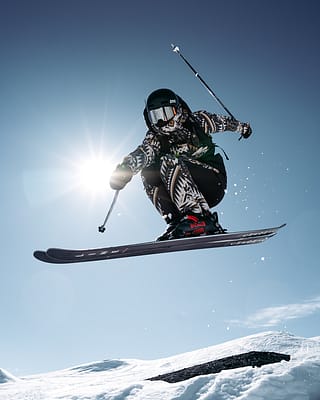Easy air tricks to learn on skis
In this instalment of our trick series, we spice things up a little and learn how to add some tricks to that sweet air time! We will go through three easy to learn tricks and techniques that can add a lot of style and fun to your skiing!

We will start with the basics, helping you build your confidence and teach you the best easy air tricks to learn on skis. This way, you can expand your ski trick skill set and learn to dominate on the mountain. The entire mountain will be yours to explore in the most creative way before you know it.

Before sending it off jumps and rollers, it’s crucial to build a solid foundation. Having a strong stance, proper ski control, and knowing how to fall safely will help you avoid injuries. A helmet is non-negotiable, and back protectors or padded shorts can be a game-changer when practicing new tricks.
Start small—gentle rollers and small jumps are the best places to get comfortable with being in the air before moving on to more advanced features. Learning how to pop correctly and land with control will make every trick easier and smoother.
Taking ski fashion to the slopes
As you progress in mastering these exciting air tricks, it's crucial to understand that your proficiency isn't just about the tricks themselves. Your equipment plays a substantial role too. Skiing isn’t just about looking good—it’s about having the right gear to help you move freely and stay warm while practicing new tricks. Choosing outerwear that allows flexibility will make a noticeable difference when trying to get into different body positions mid-air. Slimmer-fitting ski pants with a bit of stretch can help prevent restriction when bending your knees for takeoff and landing. Gloves with a good grip are also essential, especially if you plan to start working on grabs later on. In particular, your ski attire can significantly enhance your style, confidence, and overall performance on the snow-covered slopes. If your ski wardrobe is yearning for those essential additions, fear not! Check out our new collection of women's ski coats or a ski coat for men today!
How to ollie on skis
First up is the Ollie. We have previously learned how to hit jumps with the pop technique. Ollie is a similar move; it is basically a pop done from the tail of your skis.
And it looks a bit cooler and locks up a whole new bag of tricks you can do with it.
Start standing still with your skis close together. Then put pressure on the nose of your skis by leaning forwards.
Then move the pressure back to the tails of your skis by rolling your hip back over the tails with bent knees.
Slide your feet forward simultaneously to help transfer your weight to the back of your skis.
Then pop by extending your knees fully, leaning your shoulders forward and raising your arms. One common mistake beginners make when learning to ollie is relying too much on arm movement instead of using the flex of their skis. The real power comes from shifting weight properly and pressing into the tails. Practicing ollies on flat terrain before trying them off small bumps will help with timing and balance. Once comfortable, try incorporating them into natural features on the slopes, like rollers or small jumps, to get a feel for using them in real skiing situations.

And congratulations, you just did your first Ollie!
And for a good landing, make sure to push your hips forward when the skis have left the ground.
Once you feel comfortable with doing Ollies standing still, take them to the slopes and have fun with them!
Check out this video for a breakdown of the Ollie.
How to 180 on skis
Once you’ve mastered the ollie, the next step is learning a basic rotation—the 180. This trick introduces controlled spinning and will help you feel comfortable landing switch (backwards), an essential skill for progressing in freestyle skiing.
To start, focus on winding up your upper body slightly before takeoff. As you pop into the air, let your shoulders lead the rotation while keeping your skis together. Spot your landing over your shoulder and prepare to land with soft knees to absorb impact. Practicing on small jumps or side hits will help build confidence before trying it off bigger features.
How to do shifty on skis
The shifty… What is there to say? It might be one of the most useful techniques you can learn on skis. And as if that was not enough, you can make it look really cool.
Beyond being a stylish trick, the shifty is incredibly useful for fine-tuning air control. It teaches you how to manipulate your body mid-air, which is crucial for adjusting landings and saving slightly off-balance spins. A well-executed shifty can also be added into bigger tricks like 180s and 360s, making them look more dynamic. Start with smaller shifts before exaggerating the movement to get the timing just right.
The shifty is a counter-rotation technique, meaning that you spin your upper and lower body in two different directions.
Besides that, shifty is a cool trick; you can also use the technique to save over or under-rotated spins, hit rails and a whole lot more.
Convinced yet? Let’s learn some shifty!
To start practising Shifty, you should know what a pop is and how to use it.
Read all about how to hit jumps on skis here.

You practising this by doing the pop technique in your ski boots only.
Pop and twist your feet, knees and hip one way and at the same time, counter-rotate by twisting your upper body and arms the other way.
For example, twist your feet, knees and hip to the left. Twist your upper body and arms to the right.
Then before you land, unwind the twist and land with your skis and upper body straight forward again.
When you got this unlocked, which is fairly easy if you already know how to pop on skis, let’s start drilling it on the slopes!

Start with finding a jump with a size that you are already comfortable with, and do a perfectly timed pop as we learnt in the first ski trick series.
Once you start leaving the jump, do exactly as you practised in your ski boots. You can start small and do minor shifty’s. And as you get more comfortable, counter-rotate more and more until you have a tweaked shifty.
Once you have this technique, you can use it to save an under-rotated spin; just counter-rotate (do a shifty) so that your legs rotate more than your upper body. And boom, you just saved yourself from crashing.
You can also use the technique to hit rails and boxes. Pop before the rail and do a shifty so that your skis hit the rail at a 90-degree angle and your upper body points forward. And then counter-rotate when leaving the rail to land parallel to the slope.
This video shows good examples of Shiftys and how to practice them.
Shifty tail drag on skis
There are probably a million ways you can spice up your shiftys, but a shifty tail drag is a really cool-looking trick that is fairly easy to learn once you master the shifty.
Before you start practising shifty tail drags, make sure you practised your shifty’s to the point where you are comfortable doing them on different features.
Rollers are a good spot to practice shifty tail drags, a roller is a big knuckle on which a kicker is placed.
But instead of hitting the jump on the roller, you go on the side of the jump and pop over the roller.
This will give you quite a bit of airtime, but you will always be close to the roller.

You want to time the pop so that you are before the top of the roller. This way, you will be close enough to drag the tails. If you time the pop like a normal jump from the top of the roller, you won’t be able to drag your tails.
Now that you know what a roller is and how to time your pop in it, you do a shifty. Before going for a full tail drag, try exaggerating the shifty movement on regular jumps. The goal is to get comfortable extending your legs backward while keeping your upper body stable. Once you can tweak your shifty without losing balance, add in the tail drag by lightly tapping the snow. Keeping a low center of gravity will help maintain control, and starting on gentle rollers will make it easier to get the feel for the movement.
And when you clear the roller with your shifty, start dragging your tails on the roller.
When your drag is coming to an end, untwist your body.
Shifty tail drag is the first trick explained in this video; check it out!
You might need to practice this quite a bit, but once you start to understand the move, you will feel it is actually quite easy. And then the fun part begins.
Start playing around with the shifty tail drag, do it all over the mountain and try it in all different scenarios.
That’s how you really learn to master the trick.
FAQs
How can I ensure safety while practicing ski tricks?
Firstly, ensure you've mastered the basic skills before trying tricks. Wear safety gear, including helmets and pads. Learn and practice new tricks under expert guidance in a controlled environment, often a terrain park.
How do I land safely after a trick?
The key to a smooth landing is absorbing impact with your legs while keeping your weight centered. Avoid landing too far back on your skis, as this can cause you to wash out. If landing switch (backward), keep your shoulders relaxed and your eyes looking in the direction you’re going to maintain balance.
What’s the best way to practice tricks without hitting jumps?
A great way to build air awareness is by practicing jumps on flat ground. Use a gentle slope to pop and get used to being in the air before moving on to real features. Trampolines and balance boards can also help develop coordination and confidence before trying new tricks on snow.
What specific skills do I need for park skiing?
Park skiing requires fundamental skiing skills as a foundation. Upon that, skills like jumping and landing correctly, box and rail sliding, as well as spinning and grabbing in the air are essential. Also, confidence and a proactive mindset are important in park skiing.
Related reading








